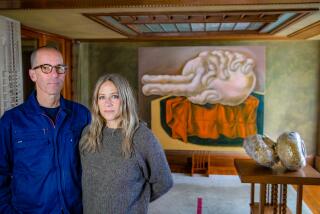Original n.: 1. Timothy Ferris; 2. Nelson clocks
- Share via
Often, ON A WHIM
and for pure pleasure, I’ll look up a word in the dictionary that I already know, one so familiar, so common, that the meaning has lost its sharpness. It’s like looking at a chair but not really seeing it -- its lines and colors and textures, its chairness, if you will -- because we instantly know it to be a chair and nothing more, and that’s the end of it. And yet it is more, much more.
Integrity is one such word I checked out again a few months ago, and in so doing, felt a tingle of understanding, the full complexity suddenly evident to me in a way I’d not experienced before, or had forgotten. It revealed itself with an unexpected freshness, opening up a richer way of thinking about the implications. It wasn’t the first meaning, the one I could have recited almost verbatim, about adhering to a code or standard of values, but the second and third meanings, about soundness, about being undivided. About completeness. Being whole.
And because I’ve been bandying about “original” lately -- wondering about it in the design world, wondering why I seldom apply it to objects or people anymore (if I’m being honest) -- I visited the dictionary again. Nothing particularly novel happened for me on the page, no rebirths of meaning, just a reminder: inventive, I read. Being the source from which imitations arise. An authentic work. One that is odd or singular: eccentric.
I miss the thrill of saying, and meaning it, that something or someone fits the bill of originality. It happens, of course, but not nearly often enough to satisfy that inchoate longing most of us have to be in the presence of The Real. I find it most often in the studios of artists or the work spaces of writers, where the air feels feverish with risks and creative industry, with spontaneity and the suggestion of more to come, any minute now, just hang on. Fertile artistic environments have the instantaneous effect of arousing one’s desire to live riskily and feverishly and spontaneously too, in keeping with a truer, more primal nature.
I feel certain that were I to spend any time at all at science writer Timothy Ferris’ rural observatory in Northern California, I’d be galvanized, probably exhilarated. I feel equally certain that he’s an original: odd, singular, eccentric and, most of all, authentic. His work, the way he lives his life, is all of a piece, perfectly consistent with who he is.
It calls to mind my first visit to Charleston in Sussex, England, a farmhouse that novelist Virginia Woolf found for her sister Vanessa Bell, an artist, and her husband, art critic Clive Bell. The fabled Bloomsbury group, a circle of writers, artists, designers and critics, retreated there during World War I and set about applying their aesthetic principles to everything in sight -- walls, doorjambs, furniture, rugs, pillows, lampshades, you name it. If it was in the house, they put a brush or a needle and thread to it.
Many of them were part of the Omega Workshop, founded to create decorative arts for the home, and decorate they did: Their work married the Arts and Crafts movement with Modernism, became a precursor to the British Art Deco movement of the ‘20s and exerted a profound influence on American decorative arts.
The farmhouse was a dazzling riot of colors, irreverent, witty, cheerful, idiosyncratic and never, ever, a place that took itself too seriously. The inhabitants -- the Bells, painter Duncan Grant, artist Roger Fry, economist John Maynard Keynes among them -- lived and worked unconventionally, and they stamped their voice and personalities on the very character of the house. It still reverberates with their presences, as though just to your left or right one of them will emerge, inviting you to stay for a cup of tea and engage in some of the fun while they paint their canvases or write their treatises.
In a foreword to “Bloomsbury Needlepoint,” about the needlework the Charleston group engaged in, Angelica Garnett, the daughter of Grant and Vanessa Bell, wrote that they had rediscovered the purity of spirit a child has in making drawings simply for the fun of it: “This is the kind of second childhood that can only be achieved by those who have made the choice of giving themselves wholly to their ideal or vision; but I think it is one we all envy and would give a lot to experience.”
They inspired, and they were imitated, as all originals inevitably are, even if it’s an inanimate object -- witness George Nelson’s 1948 ball clock or Alvar Aalto’s 1933 stackable stools, iconic designs that continue to be re-imagined. We copy, not just because we can’t come up with anything on our own, but because we detect the bravery of authenticity, and we want a taste of it, a big juicy slice.
We want a life lived whole. A friend of Grant’s wrote of him, “All he wanted to do was observe, and, on the basis of what he saw, live in a world of his own making.”
Like Timothy Ferris, living in a world of his own making, who shows us not just the infinite universe out there, but a whole, a complete universe in himself: And like every original, he reflects back to us our own potential for making the worlds we want, the potential for how life might be, how it ought to be, if we’re going where we really want to go.
Barbara King, editor of the Home section, can be reached at barbara.king@latimes.com.
More to Read
The biggest entertainment stories
Get our big stories about Hollywood, film, television, music, arts, culture and more right in your inbox as soon as they publish.
You may occasionally receive promotional content from the Los Angeles Times.









